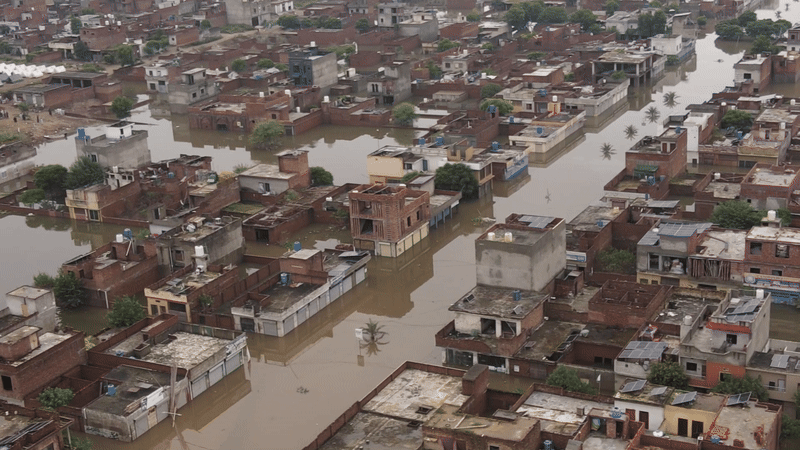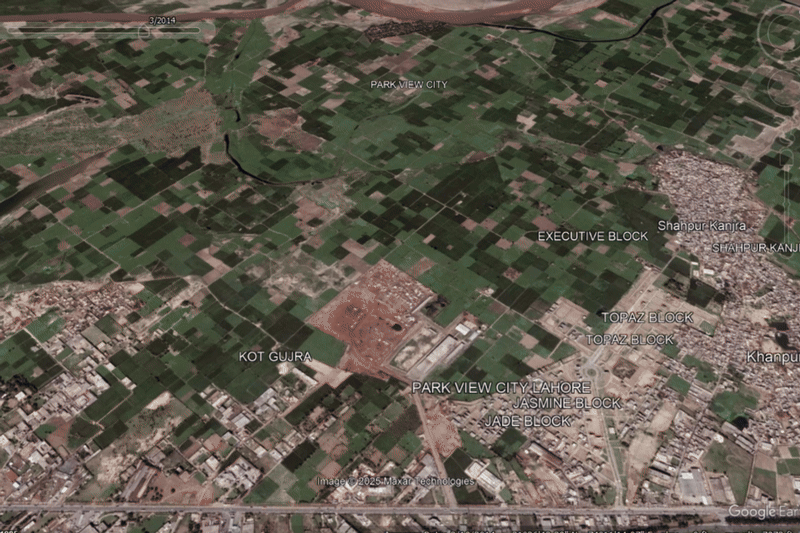Punjab flooding diffuses surge; Southern Pakistan avoids forecasted super flood
Irrigation experts say encroachments and emergency breaches in Punjab’s Ravi, Sutlej and Chenab spread water across floodplains, reducing velocity into the Indus
Akhtiar Khokhar
Special Correspondent
Akhtiar Khokhar is a one of the karachi-based senior journalists. He has been doing investigative reporting for Pakistan's mainstream print and electronic media for the past 33 years, especially highlighting corruption and bad governance in government institutions and development projects.

Floodwaters surround homes in Theme Park View Society, Lahore, on August 29, 2025. These developments encroaching on the riverbed helped spread the deluge, protecting Sindh from catastrophic flooding.
Nukta
National warnings of extreme flooding in Sindh on September 4 and 5 did not materialize
Despite the lower peak, embankments in Sindh have failed at even 300,000 cusecs in past
Based on current patterns, flows at Guddu are expected to remain under 700,000 cusecs
Pakistan’s southern Sindh province braced for extreme flooding this week after India released large volumes of water upstream, swelling rivers in eastern Punjab and prompting national warnings that the surge could hit the Indus River by early September. By Friday evening, the feared deluge had not arrived, with flows at a key control point far below forecast levels.
Punjab and Sindh are neighboring provinces in Pakistan; Punjab lies to the east, while Sindh sits downstream to the south along the Indus, the country’s main river system. Authorities warned that water rushing through Punjab’s tributaries could combine in the Indus and threaten Sindh’s defenses at Guddu Barrage, a major flow-control structure on the river.
Starting August 17, 2025, India released heavy outflows into rivers that run toward Pakistan, driving destructive floods in parts of Punjab. The National Disaster Management Authority said the combined surge could push the Indus at Guddu Barrage to between 900,000 and 1.1 million cusecs (cubic feet per second), and advised Sindh to prepare for an “extreme” flood between September 4 and 5.
Sindh Chief Minister Syed Murad Ali Shah convened emergency meetings and the province announced readiness measures, stoking public concern across low-lying districts.

But the projections did not materialize. According to the Sindh Provincial Disaster Management Authority, inflow at Guddu Barrage measured 359,570 cusecs on September 5, with an outflow of 327,481 cusecs—well below the threshold for severe flooding defined as more than 900,000 cusecs.
River encroachments reduced water flow
Syed Mazhar Ali Shah, former Chairman of the Indus River System Authority (IRSA) and irrigation expert, stated that extensive encroachments within Punjab's rivers—Ravi, Sutlej, and Chenab—protected Sindh from severe flooding. He explained that due to massive illegal construction within riverbeds, water could not follow its natural course, resulting in reduced flow velocity.
He explained that authorities had treated rivers like the Ravi and Sutlej as dormant waterways, permitting housing developments, highways, and other construction within their beds. However, he emphasized, "Rivers never die, and this flood proved that. Due to encroachments and obstructions, water carved new paths, spread across vast areas, and caused destruction."
He noted that when water's natural course is blocked, it inevitably creates alternative routes, which is precisely what occurred during Punjab's recent floods.

The Sindh-based irrigation expert further explained that these obstructions caused river water levels to rise, forcing Punjab's administration to breach embankments at multiple points to protect barrages and irrigation infrastructure. Consequently, millions of acres of land and thousands of villages were submerged, displacing millions of people.
He added that due to multiple breaches and widespread flooding in Punjab, the velocity of floodwaters decreased, which explains why the massive surge expected at Guddu Barrage by September 5 never materialized. Consequently, all predictions of severe flooding with flows of 900,000 to 1.1 million cusecs at Guddu Barrage proved incorrect.
He emphasized that this outcome was unforeseen by the NDMA and other institutions, who were unaware of the extent of river encroachments in Punjab.
Sindh risk remains despite reduced flow
The former Chairman warned that given the current condition of Indus embankments, the risk of flooding in Sindh has not been entirely eliminated. While acknowledging the Sindh government's claims of preparedness for severe flooding, he noted that historically, even flows as low as 300,000 cusecs had caused breaches due to negligence. Therefore, flows of 500,000 to 600,000 cusecs must not be underestimated.
Based on current river flow patterns, he projected that Sindh would not receive more than 600,000 to 700,000 cusecs of water. He explained that even if the flow reached 700,000 cusecs, it would last only a few hours to a day at most, while 600,000 cusecs could persist for three to four days. "Thankfully, God's mercy reduced the quantum of water reaching Sindh. But if, despite this reduced flow, any embankment in Sindh breaks and causes flooding, it would be a great misfortune."
He noted that the embankments are constructed of mud and compromised by holes created by rodents and wild animals, further weakened by rainfall and cracking. Therefore, both the Sindh government and the people of Sindh must remain on high alert under these circumstances.










Comments
See what people are discussing